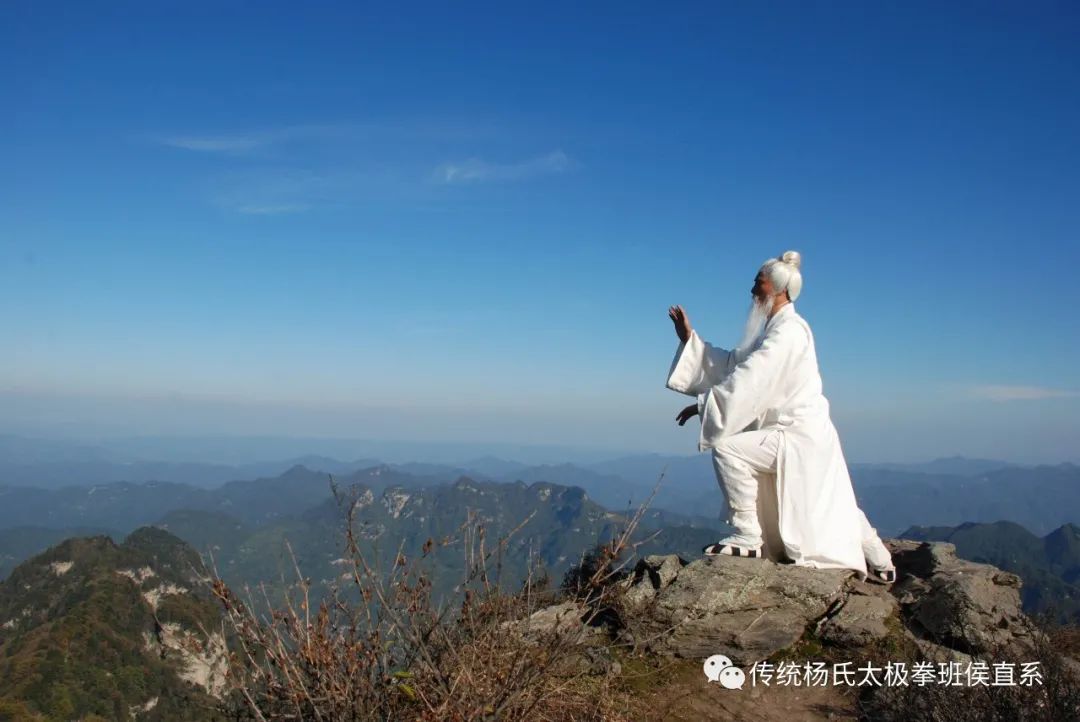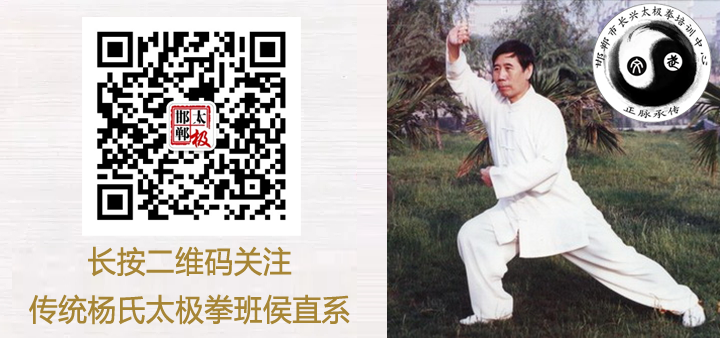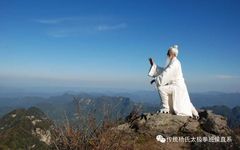1、虚灵顶劲 (Xu Ling Ding Jin)
Practicing Tai Chi requires 虚灵顶劲, where the spirit is concentrated at the top (This concept suggests that “顶头悬” (Ding Tou Xuan) and “神贯顶” (Shen Guan Ding) are two different mental activities. “顶头悬” is also known as 悬顶 (Xuan Ding), 提顶 (Ti Ding), 拔顶 (Ba Ding), and 吊顶 (Diao Ding). The specific practice method is: in your mind, imagine a rope pulling the Baihui point (百会穴) at the top of your head upwards, causing the whole body to gently lift.“神贯顶” (Shen Guan Ding) is also known as 贯顶 (Guan Ding) or 虚领顶劲 (Xu Ling Ding Jin), where the practice method involves a gentle upward force from within.
The essence of practicing Tai Chi with 虚灵顶劲 is to keep the head upright, with the Baihui point gently lifted as if a rope is suspending it. It is as if there is a drop of water on the top of the head that should not fall. This is all guided by the spirit, with the jaw slightly retracted, the neck relaxed, and the tongue touching the palate. Tai Chi requires maintaining a feeling of lightness and alertness at all times.
There is a spirit of having the head reach for the sky while the feet are grounded in the earth. However, this is all mental; one should not exert force upwards. Exerting force upwards will lead to stiffness and loss of sensitivity. During practice, as long as the feeling of 虚灵顶劲 is maintained, the spirit can naturally lift, and the Qi and blood will flow smoothly.(During practice, the head should be lifted, but the neck muscles should not be stiff, and the head movements should coordinate with the body’s position and direction changes.)

Practicing Tai Chi emphasizes 虚灵顶劲, with the Qi sinking to the 丹田 (Dan Tian), which is located three inches below the navel. During practice, one should use their consciousness to guide their breathing, allowing the Qi to sink down to the 丹田.
Beginners should not overly pursue the effect of Qi sinking to the 丹田 and must not intentionally hold their breath to inflate the abdomen. It is important to understand that Qi sinking to the 丹田 is a natural result of the body being completely relaxed. As long as the body is relaxed, calm, and at ease, first relaxing the mind and then the body, both the mind and body will be relaxed. The Qi will naturally sink and flow into the 丹田, which learners must remember.
2、沉肩坠肘 (Chen Jian Zhui Zhou)
Relaxing the shoulders means allowing the shoulders to drop down, also known as 塌肩 (Ta Jian). The shoulders should not be raised; raising them causes the spirit to rise, hindering the flow of internal Qi and blood. Dropping the elbows means that the elbows should have a sense of relaxation and downward sinking, hence during Tai Chi practice.
The arms should never be straight; they should be slightly bent, maintaining a curve, with the elbows relaxed and feeling a sense of internal heaviness. This heaviness is soft on the outside but strong on the inside, like cotton wrapped around iron. Once mastered, it penetrates inward.Its power is boundless.
To drop the shoulders, one must relax the shoulder joints to prevent them from rising; then, with awareness, stretch the shoulder muscles and ligaments to allow the shoulders to sink down while slightly embracing forward (i.e., slightly pulling in the front).Dropping the elbows means that the elbow tips should always have a downward direction.Except for actions where the elbows are higher than or level with the shoulders, the elbow tips should point downwards.
3:坐腕舒指 (Zuo Wan Shu Zhi)
Relaxing the fingers means that the fingers naturally spread, with the palms slightly closed, and the tiger mouth forming an arc, maintaining the correct hand shape.“坐腕” (Zuo Wan) means that the wrist joint is raised towards the back of the hand and the tiger mouth side, and slightly sinks down.In the “拳经” (Quan Jing), it is said, “When practicing, the force is generated from the waist, transmitted to the shoulders, reaching the arms, and manifested in the four extremities; its root is in the feet, generated from the legs, governed by the waist, and manifested in the fingers.”
This shows the important position of hand shape and technique in the completion of Tai Chi movements. The awareness of the movement, the connotation of the movement, and the quality of the movement all reflect the hand technique in the final stage of the posture.
The 坐腕 requires that during the wrist’s flexion and extension, the wrist should neither be stiff nor too soft, but should have a resilient sinking.The 坐腕 action cannot be absent, nor can it sink too much.Without the 坐腕, the arm movements will inevitably be stiff, and if the 坐腕 sinks too much, it will destroy the integrity of the movement.Additionally, the relaxing of the fingers and the 坐腕 must be coordinated with the dropping of the shoulders and elbows and the overall movement.
4:含胸拔背 (Han Xiong Ba Bei)
含胸拔背 is a Tai Chi term (other martial arts may also use this term), referring to a posture where, for example, when you sit on a chair, the body is relaxed, and both hands are placed on the legs, the chest is concave, which is 含胸 (Han Xiong), meaning to contain inward. At this time, the back naturally protrudes outward, forming an arc, which is 拔背 (Ba Bei).It should not be forced; it should be natural, and the top of the head and the tailbone should be aligned vertically.The purpose of 含胸拔背 is to create an outward curve in the back, which, when the arm’s soft sinking strength is developed, will feel like the arms and back are forming an outward supporting circle, which is the supporting strength of Tai Chi.
5:松腰敛臀 (Song Yao Lian Tun)
What does 松腰敛臀 mean in Tai Chi, and how to achieve it? Tai Chi requires 含胸 and sinking Qi, so when 含胸, the waist must be relaxed.Relaxing the waist not only helps to sink the Qi and stabilize the lower limbs but also plays a leading role in the movement’s forward and backward rotation, using the torso to drive the limbs’ activities and the integrity of the movements.
敛臀 means slightly drawing in the hips based on 含胸 and 拔背. During 敛臀, one should relax the muscles of the hips and waist as much as possible, allowing the gluteal muscles to expand outward, and then gently draw them inward, as if using the hips to control the changes in body movements, adjust the stability of the center of gravity, and facilitate the transmission of force to all parts of the body.Tai Chi requires the waist to be relaxed, heavy, and straight.The waist must be “松沉” (Song Chen).
This is to ensure that the Qi can sink to the 丹田 sufficiently, allowing the upper body Qi to remain grounded, while the lower limbs are stable, strong, and flexible in movement.To prevent the back from either concaving or protruding, the waist must also be straight (having the intention of lifting and elongating will keep it straight; a straight waist indicates that the central axis of rotation does not bend or wobble, allowing the internal strength to support flexible movement in all directions without bias).
Biasing forward and backward leads to issues like stooping, while biasing left and right leads to tilting. Due to the relaxation of the entire body, the weight above the waist naturally sinks, and this weight is entirely supported by the waist, so the waist must be upright to be strong and powerful, and it must be straight to be able to lift.
In labor and sports, maintaining a straight waist is essential for effectiveness and to avoid injury.
The operation of internal strength in Tai Chi must be driven by the waist and spine to move the limbs, hence Wu Yuxiang’s “Tai Chi Classics” states, “governed by the waist.”The waist should be straight, stable, and rotate smoothly without swaying or collapsing, gradually moving to drive the internal strength and limbs like wheels.“The axle of the cart has two vital points; when it shakes, it also rotates,” refers to the kidneys rotating during the waist and spine’s rotation, providing exercise for the kidneys.
Wu Yuxiang’s “Tai Chi Classics” also states, “the waist is the master,” which metaphorically means the waist must be as upright as the central flag of an ancient army.In every fixed posture, the waist and hips should be slightly relaxed to facilitate flexible movements, stabilize the center of gravity, and allow the internal strength to be transmitted through the centrifugal force of the waist’s rotation to the tips of the limbs.
If the waist is not relaxed or straight, the hips will easily protrude, and the tailbone will not be aligned, adversely affecting “神贯顶” (Shen Guan Ding) and “力由脊发” (Li You Ji Fa).“Tai Chi Classics” also states, “the source of intention is in the waist gap,” referring to the two kidneys, commonly known as the waist eye. The ancients believed that the kidneys are the source of internal Qi, so Chen Xin’s “Tai Chi Classics” states, “Qi is generated from the kidneys.”When the kidneys are strong, the essence is sufficient, the Qi is abundant, the spirit is clear, the eyes are bright, and the body is strong, hence the emphasis in the “Tai Chi Classics” to always pay attention to the waist.
The movements of the waist are greatly related to fitness and combat, so beginners must first pay attention to relaxing the waist, as well as ensuring it is straight and heavy.On the basis of relaxation, attention to straightness and heaviness can avoid hard pressing down or hard pulling up, which would affect the flexibility of the waist’s rotation.Every martial art emphasizes the use of waist strength; when used properly, it can concentrate the body’s strength at a single point.
Tai Chi practitioners have said: “The palms, wrists, elbows, and shoulders, the back, waist, hips, knees, and feet, all nine joints’ strength is generated from the waist.”The secret of throwing techniques emphasizes “twisting the waist to change the face,” highlighting the importance of the waist in combat training.
When performing the bow stance in Wu-style Tai Chi, although the upper body leans forward, the waist and body must remain upright, with the top of the head aligned with the heels, forming a straight line, which is a form of “斜中寓直” (Xie Zhong Yu Zhi).
6:圆裆松胯 (Yuan Dang Song Kua)
圆裆松胯 is an important factor in practicing Tai Chi to achieve relaxation and sinking, ensuring that the body remains upright and centered during practice, which is an easily overlooked principle for practitioners.
圆裆 means that the lower limbs should form a rounded shape during various stances, neither squeezing nor intentionally spreading. Squeezing makes it tight, while spreading makes it loose.It is necessary to keep the groin slightly open, forming an appropriate rounded state.The knees should slightly point inward, aligned with the toes.The perineum should be slightly lifted, and with the waist and hips relaxed, the hips should draw in, aligning the perineum with the Baihui point vertically, allowing the spirit to flow through.
The hips connect the pelvis and hip joints.In Tai Chi, from the beginning to the end of the movements, the lower limbs should remain in a semi-squat position, ensuring that the hips are sufficiently relaxed while sinking down, which helps form the correct body shape during practice;it can lower the center of gravity, promoting stability in the lower body;it allows the lower limbs to be light and agile, facilitating smooth footwork.
7:气沉丹田 (Qi Chen Dan Tian)
The 丹田 is located three inches below the navel. 气沉丹田 means that during practice, one should maintain a natural state without forcibly pressing the Qi down.Because “the innate Qi should be stable, and the acquired Qi should be smooth.”The acquired Qi should flow naturally, meaning that breathing should be natural.When the abdomen is stable, breathing will naturally be smooth, and the lower body will be stable.
The practice of 气沉丹田 involves refining essence into Qi, accumulating internal Qi to develop internal strength.Then, refine Qi into spirit, enabling the internal strength to possess the function of “the spirit knows the coming, and wisdom hides the going.”Thus, the internal Qi and external form can match and harmonize, allowing for the technique of softening the hard and using the hard with softness in combat.
8:运动如抽丝,迈步如猫行 (Yun Dong Ru Chou Si, Mai Bu Ru Mao Xing)
What does it mean for Tai Chi movements to be like drawing silk, and steps to be like a cat’s walk?“运动如抽丝,迈步如猫行” literally means that movements should be as flexible and elongated as drawing silk, and stepping should be light and gentle like a cat, with both lifting and lowering of the feet having a light and agile feeling.
Tai Chi emphasizes “using consciousness to guide movements,” which is a form of “intuitive” exercise.Only slow movements can better embody this intuition; therefore, Tai Chi movements should be both slow and uniform, maintaining a proper constant speed, just like drawing silk evenly.If the silk is not drawn slowly and evenly, it will break.
Thus, Tai Chi movements must be continuous and unbroken, and the footwork must correspondingly be light and agile, with movements as soft and long as silk.However, “light” does not mean floating.
“Light” is a dynamic expression containing considerable weight and flexible strength.“Floating” is entirely different, being ethereal and rootless, collapsing at the slightest touch.The movement characteristics of “运动如抽丝,迈步如猫行” can be said to be unique to Tai Chi practice.

If there are any copyright issues, please contact the original author through the backend.The articles published are for learning and reference only.Please practice under the guidance of a professional teacher.

Official website: http://www.yunshuiwang.com



